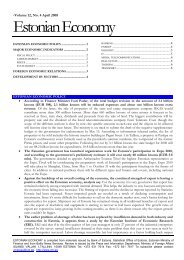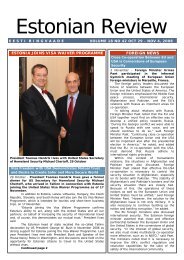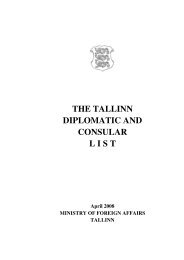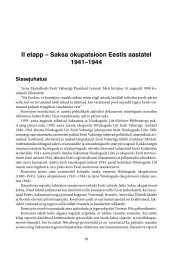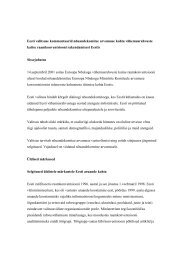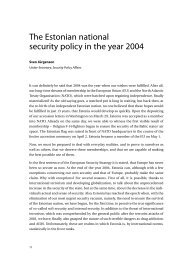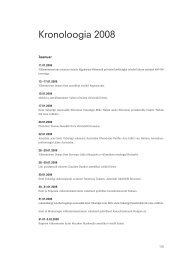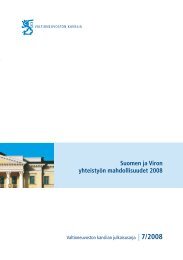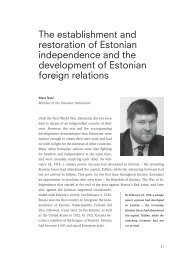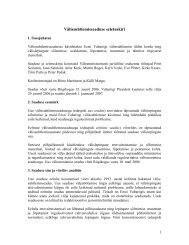Opportunities for Cooperation between Estonia and ... - Valitsus
Opportunities for Cooperation between Estonia and ... - Valitsus
Opportunities for Cooperation between Estonia and ... - Valitsus
Create successful ePaper yourself
Turn your PDF publications into a flip-book with our unique Google optimized e-Paper software.
generators in the Baltic <strong>and</strong> Nordic countries at a disadvantage <strong>and</strong> could<br />
jeopardize <strong>Estonia</strong>’s energy security.<br />
The possibility of combining the <strong>Estonia</strong>n <strong>and</strong> Finnish gas pipeline networks<br />
has been studied at length. The envisaged two-way subsea Baltic Connector<br />
pipeline would improve transmission security, give Finl<strong>and</strong> access to the Latvian<br />
gas reserves <strong>and</strong> permit the creation of a regional gas market. Considering the<br />
current stage of the project, the connection is not likely to be constructed until<br />
after 2015.<br />
More than anything else, energy production in <strong>Estonia</strong> <strong>and</strong> Finl<strong>and</strong> will be<br />
affected by the continual increase in consumption <strong>and</strong> the carbon dioxide<br />
emission ceilings imposed by the EU. For the time being, the only known<br />
option to produce carbon-fee electricity at a competitive cost is nuclear<br />
energy. Its long-term energy security is guaranteed by the large number of<br />
nuclear fuel suppliers worldwide <strong>and</strong> the relative simplicity of the fuel transport<br />
technology.<br />
Considering the closure of the Ignalina nuclear power station in Lithuania in<br />
2009 <strong>and</strong> the uncertainty surrounding the construction of a new nuclear power<br />
station, the limitations imposed by the EU on the use of oil shale as a raw<br />
material in energy production, <strong>and</strong> the lack of access to a secure long-term<br />
supply of energy from abroad, the only realistic option left to <strong>Estonia</strong> is the<br />
construction of a nuclear power station of its own.<br />
As <strong>Estonia</strong> <strong>and</strong> Finl<strong>and</strong>, after the laying of the Estlink 2 cable, will be part<br />
of the same energy transmission system, a nuclear power station in <strong>Estonia</strong><br />
should be designed <strong>and</strong> developed as a joint <strong>Estonia</strong>n-Finnish project. The<br />
joint nuclear power station project of high technical st<strong>and</strong>ards should be able<br />
to reconcile the business interests of the power companies with the long-term<br />
energy security needs of the two countries, i.e., the interests of society.<br />
<strong>Estonia</strong> could participate in the project to build the sixth nuclear reactor (OL4)<br />
in Finl<strong>and</strong> on a reciprocal basis, in which case Finnish electricity producers<br />
could be given the opportunity to invest in new generation plants to be built in<br />
<strong>Estonia</strong>. Potential projects could include the upgrading of the electricity works<br />
in Narva <strong>and</strong> various projects related to renewable energy sources.<br />
The idea of developing the Narva works is based on <strong>Estonia</strong>’s oil shale reserves,<br />
i.e., the existence of a local energy source. With oil shale, one important<br />
consideration is that its price is unaffected by world market prices. Aside from<br />
the further investments in the new combustion technology developed <strong>for</strong> oil<br />
33





